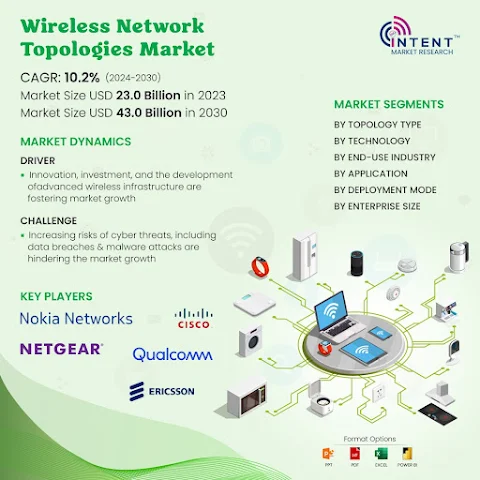The thermal management solutions market plays a pivotal role in enhancing the performance, reliability, and safety of modern devices and systems across multiple industries. With the ongoing technological advancements and increasing adoption of high-performance devices, this market is primed for exponential growth. It is expected to grow from USD 32.5 billion in 2023, at a CAGR of 5.6%, reaching USD 48.1 billion by 2030.
What Are Thermal Management Solutions?
Thermal management solutions are technologies and processes used to regulate the temperature of systems or devices, ensuring they operate within an optimal temperature range. From electronic devices to automotive systems, efficient thermal management is essential for preventing overheating, maintaining performance, and extending product lifecycles.
Download Sample Report @ https://intentmarketresearch.com/request-sample/thermal-management-solutions-market-3082.html
Key Drivers Behind Market Growth
Growing Demand for Electronics
The increasing use of high-performance electronics like smartphones, laptops, and data centers is driving demand for advanced thermal management solutions. Effective heat dissipation is crucial for improving efficiency and minimizing failures.Industrial Automation
With the rise of Industry 4.0, manufacturing and industrial automation rely heavily on thermal management technologies to maintain equipment and system reliability.Electric Vehicles (EVs)
The transition to electric vehicles has amplified the need for efficient thermal management systems to regulate battery temperatures and improve EV performance and safety.5G Infrastructure
The expansion of 5G networks introduces high-power density systems that require effective heat regulation for seamless connectivity and reliability.
Applications of Thermal Management Solutions
- Consumer Electronics: Ensuring the performance of smartphones, tablets, and gaming systems.
- Automotive: Managing thermal requirements of EVs and autonomous vehicles.
- Healthcare: Regulating temperatures in medical devices like MRI machines and diagnostic tools.
- Energy: Supporting renewable energy systems, such as solar panels and wind turbines, with effective heat management.
Technological Innovations Driving the Market
- Advanced Cooling Systems
Innovations such as liquid cooling and thermoelectric cooling systems are transforming thermal management solutions with greater efficiency. - Nanotechnology
The integration of nanomaterials has led to lightweight, highly effective thermal solutions for various applications. - Smart Systems
IoT-enabled thermal management devices enable real-time monitoring and predictive maintenance for temperature regulation.
Challenges in the Market
- High Costs
Advanced thermal management solutions can be expensive, posing challenges for small and medium-sized enterprises. - Complex Design Integration
Ensuring compatibility with existing systems often involves complex engineering and design. - Environmental Concerns
Some thermal management materials and processes may have environmental implications that require addressing through sustainable practices.
Opportunities in Emerging Markets
Developing economies, particularly in Asia-Pacific, offer immense opportunities for the thermal management solutions market. Rapid industrialization, urbanization, and the growing adoption of electronics and renewable energy systems are driving demand. Governments are also emphasizing the need for greener and more efficient technologies, further fueling market growth.
Access Full Report @ https://intentmarketresearch.com/latest-reports/thermal-management-solutions-market-3082.html
The Role of Sustainability
Sustainability is at the forefront of market trends, with an increasing focus on eco-friendly materials and energy-efficient solutions. From recyclable cooling materials to systems that reduce power consumption, sustainability is shaping the future of thermal management solutions.
Future Trends in the Market
- Hybrid Cooling Technologies: Combining air and liquid cooling for enhanced performance.
- Advanced Battery Thermal Management: Supporting the next generation of EV batteries.
- AI-Powered Systems: Enabling precise temperature control and predictive analytics.
- 3D-Printed Components: Offering customized, cost-effective solutions for thermal needs.
FAQs
What is the primary purpose of thermal management solutions?
They regulate temperature to enhance the performance, safety, and lifespan of devices and systems.Which industries benefit most from thermal management solutions?
Key industries include electronics, automotive, healthcare, and renewable energy.What challenges does the market face?
High costs, design complexities, and environmental concerns are significant challenges.How does sustainability impact thermal management solutions?
Companies are prioritizing eco-friendly and energy-efficient materials and systems.What role do emerging technologies play in market growth?
Innovations like nanotechnology, AI, and 3D printing are transforming thermal management practices.
About Us
Intent Market Research (IMR) is dedicated to delivering distinctive market insights, focusing on the sustainable and inclusive growth of our clients. We provide in-depth market research reports and consulting services, empowering businesses to make informed, data-driven decisions.
Our market intelligence reports are grounded in factual and relevant insights across various industries, including chemicals & materials, healthcare, food & beverage, automotive & transportation, energy & power, packaging, industrial equipment, building & construction, aerospace & defense, and semiconductor & electronics, among others.
We adopt a highly collaborative approach, partnering closely with clients to drive transformative changes that benefit all stakeholders. With a strong commitment to innovation, we aim to help businesses expand, build sustainable advantages, and create meaningful, positive impacts.
Contact Us
sales@intentmarketresearch.com
US: +1 463-583-2713












